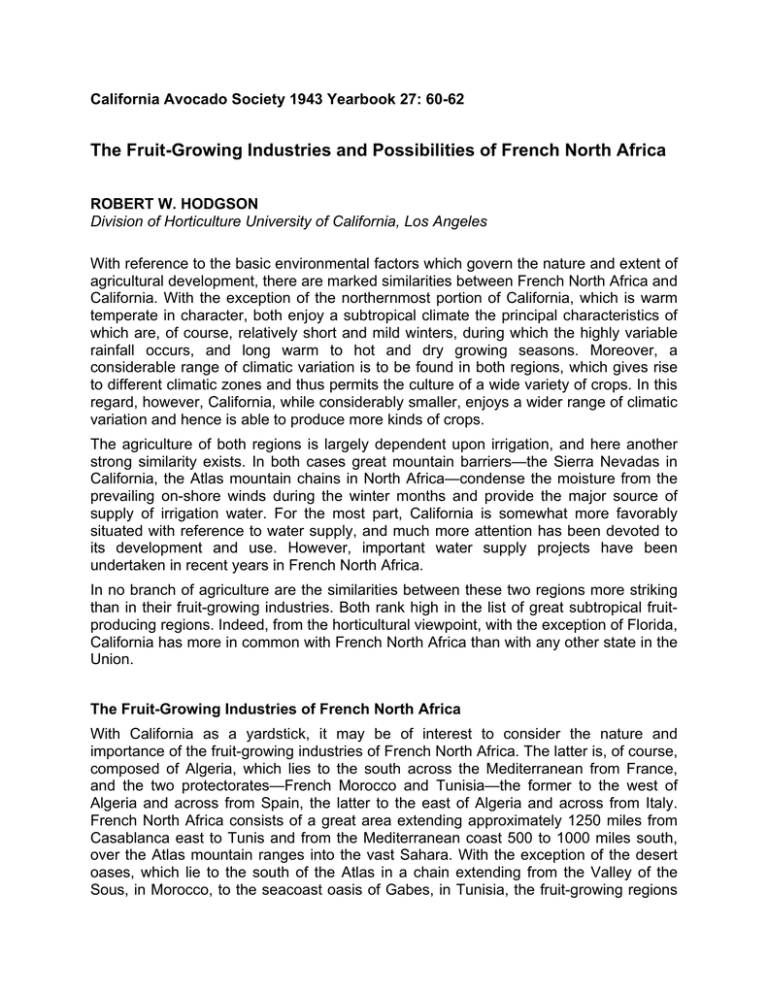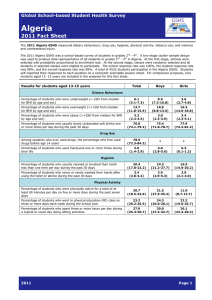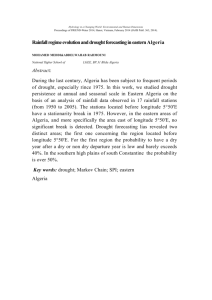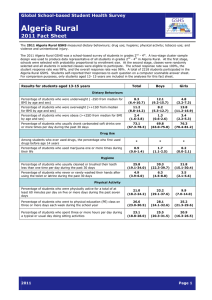The Fruit-Growing Industries and Possibilities of French North Africa
advertisement

California Avocado Society 1943 Yearbook 27: 60-62 The Fruit-Growing Industries and Possibilities of French North Africa ROBERT W. HODGSON Division of Horticulture University of California, Los Angeles With reference to the basic environmental factors which govern the nature and extent of agricultural development, there are marked similarities between French North Africa and California. With the exception of the northernmost portion of California, which is warm temperate in character, both enjoy a subtropical climate the principal characteristics of which are, of course, relatively short and mild winters, during which the highly variable rainfall occurs, and long warm to hot and dry growing seasons. Moreover, a considerable range of climatic variation is to be found in both regions, which gives rise to different climatic zones and thus permits the culture of a wide variety of crops. In this regard, however, California, while considerably smaller, enjoys a wider range of climatic variation and hence is able to produce more kinds of crops. The agriculture of both regions is largely dependent upon irrigation, and here another strong similarity exists. In both cases great mountain barriers—the Sierra Nevadas in California, the Atlas mountain chains in North Africa—condense the moisture from the prevailing on-shore winds during the winter months and provide the major source of supply of irrigation water. For the most part, California is somewhat more favorably situated with reference to water supply, and much more attention has been devoted to its development and use. However, important water supply projects have been undertaken in recent years in French North Africa. In no branch of agriculture are the similarities between these two regions more striking than in their fruit-growing industries. Both rank high in the list of great subtropical fruitproducing regions. Indeed, from the horticultural viewpoint, with the exception of Florida, California has more in common with French North Africa than with any other state in the Union. The Fruit-Growing Industries of French North Africa With California as a yardstick, it may be of interest to consider the nature and importance of the fruit-growing industries of French North Africa. The latter is, of course, composed of Algeria, which lies to the south across the Mediterranean from France, and the two protectorates—French Morocco and Tunisia—the former to the west of Algeria and across from Spain, the latter to the east of Algeria and across from Italy. French North Africa consists of a great area extending approximately 1250 miles from Casablanca east to Tunis and from the Mediterranean coast 500 to 1000 miles south, over the Atlas mountain ranges into the vast Sahara. With the exception of the desert oases, which lie to the south of the Atlas in a chain extending from the Valley of the Sous, in Morocco, to the seacoast oasis of Gabes, in Tunisia, the fruit-growing regions are situated on the Mediterranean side of the mountains. Algeria is much the largest of these countries and the most important. With considerably more than a million acres in fruits, she ranks sixth in the list of principal subtropical fruitproducing countries of the world. California, with approximately the same acreage, of which however the citrus fruits comprise about 30 per cent, ranks fourth in this list. In area devoted to the grape, which provides the largest fruit-growing industry in both, California ranks fourth in importance and Algeria sixth. Second in importance in Algeria, and in comparison a very small industry indeed in California, is date-palm culture. Algeria is the second most important date-producing country of the world, being exceeded only by Iraq. Third in importance in Algeria is the olive, in the production of which she ranks sixth. The California olive industry is scarcely a tenth as large. The fig industries of the two countries do not differ greatly in importance, California ranking fourth and Algeria sixth. By contrast, however, the California almond industry ranks fourth while that of Algeria is only tenth. Most important among fruits in California, of course, are the citrus fruits, and California is the leading citrus fruit-producing country of the world. The citrus fruit industry of Algeria, while important, is less than ten per cent as large as that of California. The six fruits just considered, in the production of all of which Algeria is important, together with the English walnut, comprise the principal subtropical fruits of world commerce. Much smaller than either Algeria or Morocco, and far less favored in natural resources, Tunisia is nevertheless an important fruit-producing country. Olive culture stands at the top of the list and so extensive and important is this industry as to give this little country fourth rank among the olive-producing countries of the world. This compares with sixth rank for her sister state, Algeria. Her date palm industry is likewise important and entitles her to sixth rank, as compared to second for Algeria. Her almond industry is slightly larger than that in Algeria and ranks ninth in world importance. We are accustomed to thinking of dry-farming as a system of non-irrigated agriculture, based on rigid soil moisture conservation, developed in the Great Plains section of the United States. Much the greater part of the Tunisian olive industry exists in an area where the rainfall ranges from 8 to 15 inches and no irrigation is possible. The trees are spaced 25 meters apart and no weeds whatever are allowed to grow. Perfect adjustment seems to exist between water supply, as conserved in the soil, and use by the trees. This industry represents the re-establishment, under French guidance and encouragement during the past 50 years, of the Roman olive industry, which flourished during the early centuries of the Christian Era. Truly, dry-farming did not originate in the United States. Morocco, larger and far richer in resources, has been under French control scarcely a third of a century, and has hardly had time as yet to develop into an important fruitgrowing country. It is nevertheless ninth in importance in olive production as compared to fourth for Tunisia and sixth for Algeria. Its almond industry, however, is larger and more important than those of its sister countries, ranking fifth and closely approaching that of California. Its date palm industry is somewhat less important than that of Tunisia, its rank being eighth among date-producing countries. All three countries are important producers of certain fruits, such as the carob, tuna or prickly pear, and pomegranate, on which statistics are not available. And in recent decades small acreages of plums, apricots and peaches have been planted for the early fruit markets, both local and in France. The facts just presented clearly show that French North Africa is one of the great fruitgrowing regions of the world, that there are marked similarities between its fruit-growing industries and those of California, and that in extent and importance they compare favorably with ours. The Fruit-Growing Possibilities of French North Africa It now remains to consider briefly the fruit-growing possibilities of French North Africa. From the technical point of view, practically without exception, the fruit-growing industries of North Africa offer great possibilities for improvement. The substitution of superior varieties, already available, the use of better orchard management practices, the employment of modern methods of fruit-handling and preparation for market—these are all very much needed and will contribute greatly to yield and quality of product and its favorable acceptance in the export markets of the world. In this connection it should be noted that substantial progress toward these objectives has been made during the past two decades. Horticultural research stations and programs have been developed. Brichet and Fauvel in Algeria, Bey Rozet and Brayard in Morocco, Rebour and Guillochon in Tunisia are among the well-known horticulturists of the Mediterranean Basin and have assisted materially in the modernization, now under way, of the fruit-growing industries of French North Africa. Moreover, national standards and trademarks have been adopted for the export trade, in the development of which invaluable assistance has been provided by Mr. Raymond Ricaud, Trade Commissioner of France, in San Francisco. The possibilities for further expansion depend largely on the extension of irrigation and hence on the development and utilization of irrigation water supplies. Because of her superior natural resources and greater freedom from traditions and governmental restrictions, there can be little doubt that Morocco affords the greatest possibilities for further development in fruit-growing. Irrigation projects now planned or under way in Algeria will materially increase her fruit-growing possibilities. The scanty water supply of Tunisia will hardly permit of much increase in irrigated fruit acreage. One serious deterrent to the culture of the soft-fleshed fruits in French North Africa is deserving of mention, however, namely the Mediterranean fruit-fly. Satisfactory and economical control methods for this scourge have not yet been developed. Contributions From French North Africa to California Horticulture No discussion of this subject would be complete without mention of contributions to California horticulture from French North Africa. Of these one of the most important is the famous dessert date variety, Deglet Nur, which comprises about 85 per cent of our present production. Another of considerable importance is the well known Tokay grape, which almost certainly originated in Algeria. Still another is the large-fruited Barouni olive now grown to some extent in northern California. And finally, there is the Clementine or Algerian mandarin which is now grown on a limited scale in the Coachella and Imperial valleys.





